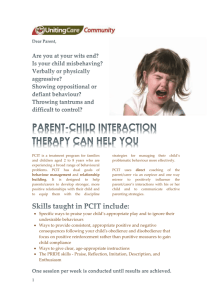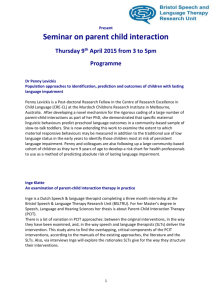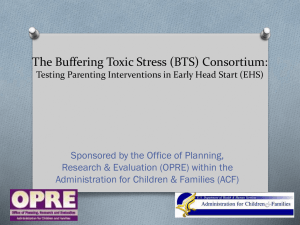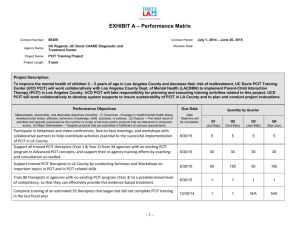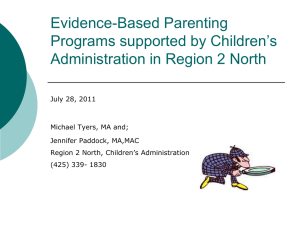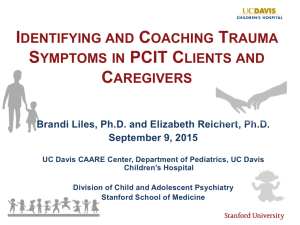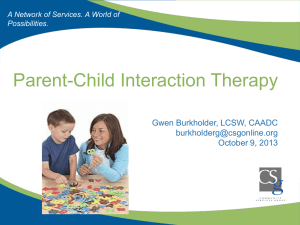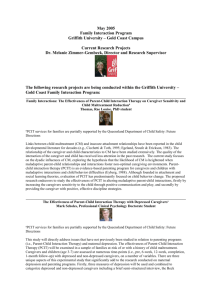Culture-Specific Information - National Child Traumatic Stress Network
advertisement
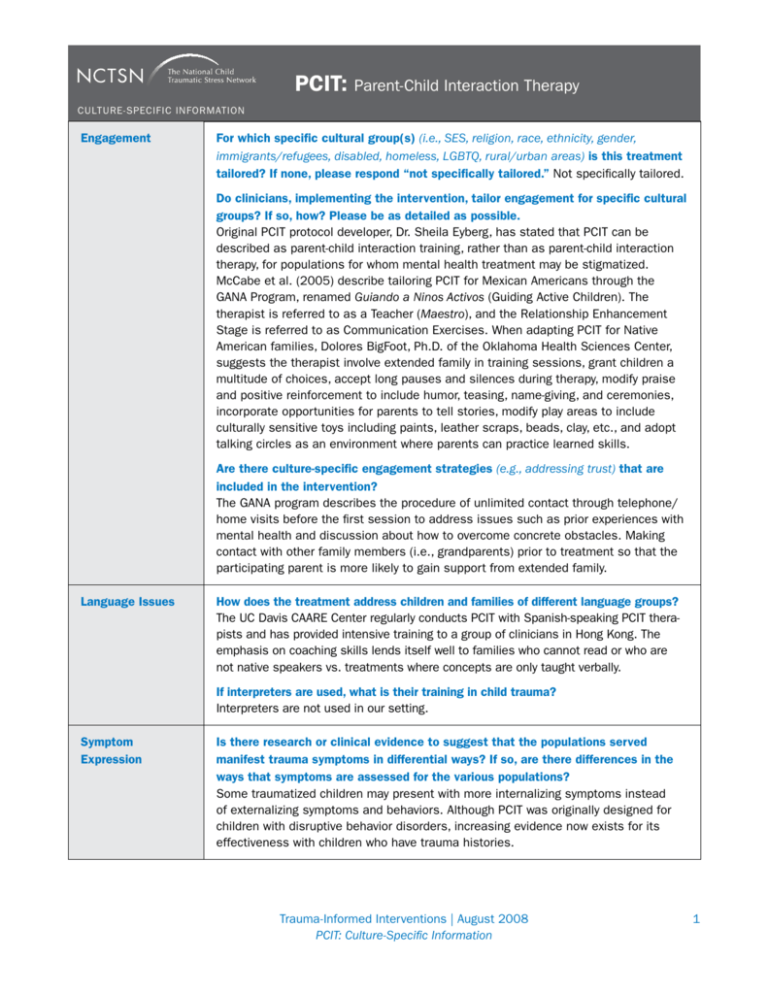
NAME:Parent-Child PCIT: General Name Spelled Information Interaction Out Therapy 0000: Culture-Specific Information CULTURE-SPECIFIC INFORMATION Engagement For which specific cultural group(s) (i.e., SES, religion, race, ethnicity, gender, immigrants/refugees, disabled, homeless, LGBTQ, rural/urban areas) is this treatment tailored? If none, please respond “not specifically tailored.” Not specifically tailored. Do clinicians, implementing the intervention, tailor engagement for specific cultural groups? If so, how? Please be as detailed as possible. Original PCIT protocol developer, Dr. Sheila Eyberg, has stated that PCIT can be described as parent-child interaction training, rather than as parent-child interaction therapy, for populations for whom mental health treatment may be stigmatized. McCabe et al. (2005) describe tailoring PCIT for Mexican Americans through the GANA Program, renamed Guiando a Ninos Activos (Guiding Active Children). The therapist is referred to as a Teacher (Maestro), and the Relationship Enhancement Stage is referred to as Communication Exercises. When adapting PCIT for Native American families, Dolores BigFoot, Ph.D. of the Oklahoma Health Sciences Center, suggests the therapist involve extended family in training sessions, grant children a multitude of choices, accept long pauses and silences during therapy, modify praise and positive reinforcement to include humor, teasing, name-giving, and ceremonies, incorporate opportunities for parents to tell stories, modify play areas to include culturally sensitive toys including paints, leather scraps, beads, clay, etc., and adopt talking circles as an environment where parents can practice learned skills. Are there culture-specific engagement strategies (e.g., addressing trust) that are included in the intervention? The GANA program describes the procedure of unlimited contact through telephone/ home visits before the first session to address issues such as prior experiences with mental health and discussion about how to overcome concrete obstacles. Making contact with other family members (i.e., grandparents) prior to treatment so that the participating parent is more likely to gain support from extended family. Language Issues How does the treatment address children and families of different language groups? The UC Davis CAARE Center regularly conducts PCIT with Spanish-speaking PCIT therapists and has provided intensive training to a group of clinicians in Hong Kong. The emphasis on coaching skills lends itself well to families who cannot read or who are not native speakers vs. treatments where concepts are only taught verbally. If interpreters are used, what is their training in child trauma? Interpreters are not used in our setting. Symptom Expression Is there research or clinical evidence to suggest that the populations served manifest trauma symptoms in differential ways? If so, are there differences in the ways that symptoms are assessed for the various populations? Some traumatized children may present with more internalizing symptoms instead of externalizing symptoms and behaviors. Although PCIT was originally designed for children with disruptive behavior disorders, increasing evidence now exists for its effectiveness with children who have trauma histories. Trauma-Informed Interventions | August 2008 PCIT: Culture-Specific Information 1 NAME:Parent-Child PCIT: Name Spelled General Information Interaction Out Therapy CULTURE-SPECIFIC INFORMATION Symptom Expression continued If there are differences in symptom expression, in what ways does the theoretical/ conceptual framework of this treatment address culturally specific symptoms? PCIT trainers emphasize that both parent-child attachment and children’s disruptive behaviors are variously defined and expressed culturally, and they are alerted at every stage (including on the ECBI) to consult with parents about treatment goals syntonic for them in their settings. PCIT does not pathologize normal cultural variations or impose a single standard of parenting and child behavior on clients. PCIT is grounded in attachment theory, and one of its components works through live coaching by the therapist on parent-child relationship enhancement. However, expressions of normal parent-child attachment behaviors vary according to culture; therefore, researchers working with Latino and Native American populations have adapted the relationship building component of PCIT culturally. Cultural variations in tolerance for “disruptive” behavior in children are addressed in Dr. Eyberg’s teaching by asking parents during live coaching if a particular child behavior is something they want to see reduced through strategic ignoring. Assessment In addition to any differences noted above, are there any differences in assessment measures used across cultural groups? If so, please indicate which measures are used for which cultural groups. Are there normative data available for the populations for which they are being used? The Eyberg Child Behavior Inventory (ECBI) has been studied with 154 African American caregivers to test parental tolerance for misbehavior (Butler, Eyberg & Brestan, 2006). CBCL and Parenting Stress Index have been translated into Spanish and have normative data. A Chinese Version of the DPICS coding system was developed in Hong Kong. What, if any, culturally specific issues arise when utilizing these assessment measures? Reliability/validity when measures are translated Cultural Adaptations Are cultural issues specifically addressed in the writing about the treatment? Please specify. Borrego et al. (2006) discuss how the focus on enhancing the parent-child relationship in PCIT fits with the familism value in many Hispanic families. In addition, they note that the emphasis of discipline and compliance is consistent with the value of respect for authority figures. McNeil, Capage, & Bennett, 2002. Do culture-specific adaptations exist? Please specify (e.g., components adapted, full intervention adapted). GANA Program-Adaptation (McCabe et al., 2005). 2 The National Child Traumatic Stress Network www.NCTSN.org NAME:Parent-Child PCIT: General Culture-Specific Information Interaction Therapy 0000: Information CULTURE-SPECIFIC INFORMATION Cultural Adaptations continued Has differential drop out been examined for this treatment? Is there any evidence to suggest differential drop out across cultural groups? If so, what are the findings? McNeil, Capage & Bennett (2002) found no difference in drop-out rates for African American and Caucasian clients but differences may be because clients were matched on SES. Werba et al. (2002) found ethnicity predicted neither response nor attrition in PCIT. PCIT with Latino populations resulted in midtreatment attrition with non-acculturated Spanish speaking families (McCabe, 2002). Intervention Delivery Method/ Transportability & Outreach Is this a clinic-based treatment or is the treatment transportable (e.g., into home, community)? If the treatment is transportable, how is it adapted into the new setting? Is it still efficacious? Yes, preliminary data suggests in-room and in-home coaching still are efficacious. Are there cultural barriers to accessing this treatment (i.e., treatment length, family involvement, stigma, etc.)? Stigma of mental health treatment is one barrier. Engaging fathers in treatment is another (Bagner & Eyberg, 2003), but results of their study regarding father involvement suggested that scheduling sessions around fathers’ work schedules may increase participation. Are there logistical barriers to accessing this treatment for specific cultural groups (i.e., transportation issues, cost of treatment, etc.)? No transportation. Rural families may not have access. Because PCIT is a dyadic parent-child interaction, single parents with many children may find it very difficult to take part in therapy. Are these barriers addressed in the intervention and how? PCIT can be provided in-home or in-room when transportation issues are a problem. Group PCIT has been found to be successful as well, which can decrease overall costs of the treatment. Providing care for siblings during sessions can increase attendance. Partner with agencies to help them get foundation grants to provide, not only transportation but also simple toys to use for home play therapy practice between parent and child. What is the role of the community in treatment (e.g., local groups such as faith-based organizations, community groups, youth and/or parent organizations, first responders, schools)? Querido, Eyberg & Boggs (2001) designed a model of PCIT for Head Start Families and a form of Teacher Child Interaction Therapy (TCIT) has also been developed. Training Issues What potential cultural issues are identified and addressed in supervision/training for the intervention? Comfort and differences in use of praise. There are differences among clinicians/caregivers regarding child behaviors to be ignored (e.g., swearing). The PCIT therapist must be comfortable in behavioral approaches and being directive, which may pose a challenge for therapists from certain cultures and theoretical orientations. Trauma-Informed Interventions | August 2008 PCIT: Culture-Specific Information 3 PCIT: Parent-Child Interaction Therapy CULTURE-SPECIFIC INFORMATION Training Issues continued If applicable, how are potential cultural issues between the supervisor and clinician identified and addressed in supervision/training? Through open discussion and collaborative openness. For example, teaching PCIT to psychologists from Japan invites extensive exchanges about the use of labeled praises with children, differences between our cultures in the father-child/motherchild relationships, and so on. Trainers who remain open and receptive to cultural issues and differences maintain rapport with trainees. If applicable, how are potential cultural issues between the clinician and the client identified and addressed in supervision/training? Cultural differences in discipline/use of corporal punishment. This is addressed and discussed in a didactic session, and a variety of reasons are presented with opportunities for discussion with the parent (client) for why PCIT uses time-out vs. corporal punishment. Has this guidance been provided in the writings on this treatment? Yes, there is a lengthy explanation in the standard manual about timeout versus corporal spanking. Any other special considerations regarding training? Advances in technology for distance learning for rural clinicians. Lack of trained therapists in PCIT in many areas of the country References Bagner, D. M. & Eyberg, S. M. (2003). Father involvement in parent training: When does it matter? Journal of Clinical Child and Adolescent Psychology. 32, 599-605. Borrego, J., Anhalt, K., Terao, S. Y., Vargas, E. C. & Urquiza, A. J. (2006). Parent-Child Interaction Therapy with a Spanish speaking family. Cognitive and Behavioral Practice, 13, 121-133. Butler, A., Eyberg, S. M. & Brestan, E. V. (2006, January). Examination of the Eyberg Child Behavior Inventory Discrepancy Hypothesis. Paper presented at the Sixth National Parent Child Interaction Therapy Conference, Gainesville, FL. McCabe, K. M. (2002). Factors that predict premature termination among Mexican-American children in outpatient psychotherapy. Journal of Child and Family Studies, 11(3), 347-359. McCabe, K. M., Yeh, M., Garland, A. F. & Lau, A. (2005). The GANA Program: A tailoring approach to adapting Parent Child Interaction Therapy for Mexican Americans. Education & Treatment of Children, 28(2), 111-129. McNeil, C. B., Capage, L. C. & Bennett, G. M. (2002). Cultural issues in the treatment of young African American children diagnosed with disruptive behavior disorder. Journal of Pediatric Psychology, 27, 339-350. Querido, J. G., Eyberg, S. M. & Boggs, S. R. (2001). Revisiting the accuracy hypothesis in families of young children with conduct problems. Journal of Clinical Child Psychology, 30, 253-261. Werba, A. (2002). Transmission between generations. Secrets and ancestral mourning. Psicoanálisis: Revista de la asociación Psicoanalitíca de Buenos Aires, 24, 295-313. 4 The National Child Traumatic Stress Network www.NCTSN.org
